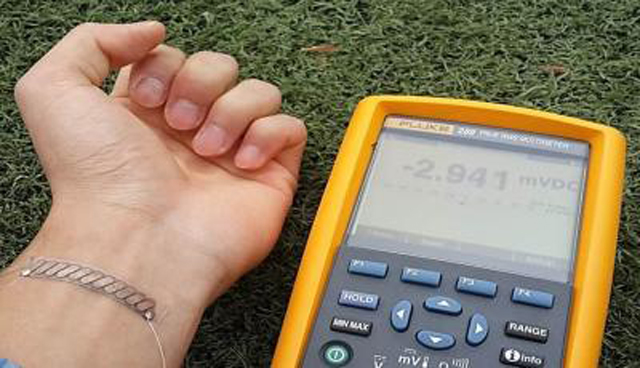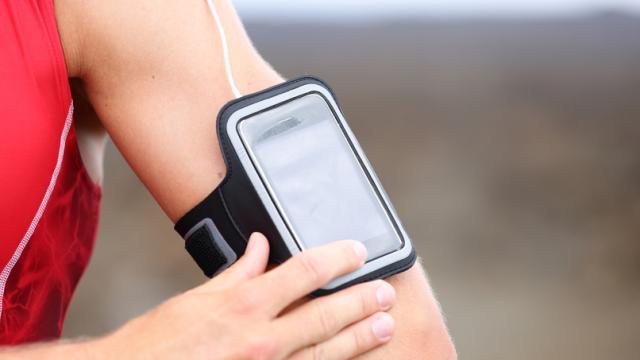The human body at rest radiates 100 watts of heat — heat that does nothing other than make crowded rooms stuffy. But body heat can be converted to electricity, and new technology is always improving the process. With the rise of wearables, the body heat-powered device becomes an ever more tantalising promise.
In theory, 100 watts would be more than enough to power your lightbulbs or your iPhone. In practice, the current technology doesn’t convert heat to electricity that efficiently, and you don’t really want to be swaddled head-to-toe in thermoelectric fabric. But we can certainly sweat our way to heat-powered watches and flashlights. In fact, these already exist.
How to Turn Heat Into Electricity
A quick primer on how heat-to-electricity conversion all works. It’s all because of a physical phenomenon aptly called the thermoelectric effect. Think USB-charged drink coolers, which use the same effect but in the opposite direction.
Thermoelectric material is made out of a doped semiconductor, such as bismuth telluride or lead telluride. When there’s a temperature difference between two sides of the material, charged particles begin to move from the hot to the cold side. This movement generates an electric current — voila, electricity. Much of the world’s electricity is in fact converted by this thermoelectric material.
But putting power plant technology on the human body has its challenges. For one, the thermoelectric effect only works when there’s a temperature gradient, which is fine when you have superheated steam. But when the human body tops out at 98.6 degrees Fahrenheit and it’s a sweltering summer day, then good luck. On a cold day, current thermoelectric materials can generate a few milliwatts of power from body heat.
The Body Heat-Powered Devices of Past and Present

Picture: Roachman
The first commercial body-heated powered gadget actually dates back to 1998, when Seiko sold 500 of its limited edition Seiko Thermic watches. It sold out in just a few months. Wayne Lee, a watch enthusiast based in Malaysia, called the Thermic a “‘must-have’ to those watch collectors whom possessed a deep passion for marvel technology.”
While Lee enthuses about the Thermic in his in-depth review, living in Malaysia quickly teaches him the limits of the technology.
However, to be frank, I would not recommend anyone from the tropics who work outdoor most of the time to purchase the watch. This afternoon when I got inside my “oven hot” car which had been exposed to the sun for several hours (I could not find a parking space under the shade this morning), the second hand stopped ticking. I was panic and quickly get back home to check the manual.
Lee, however, says he spends over 10 hours a day working in an air-conditioned room as a professor, so it’s not a problem for him.
Researchers who work with medical devices are, understandably, also very interested in harnessing body heat. The Belgian researchers Vladimir Leonov and Ruud J.M. Vullers created first a blood oxygen sensor and then a brain EEG device. The EEG device, however, was more power hungry, and volunteers complained that the heat-transferring thermoelectric material was uncomfortably cold against the skin.
While the current technology isn’t perfect, it’s not hard to use. Last year, a tenth grader named Ann Makosinski created a body heat-powered LED flashlight, which made her a finalist for the Google Science Fair. She was able to make her flashlight with Peltier tiles, small devices that convert heat to electricity per the thermoelectric effect. They’re readily available for a few bucks a pop.
You can also check out this DIY ring made with Pelltier tiles that lights up with body heat.
New Technology, New Possibilities
While that light-up ring has DIY cred, it’s kind of clunky and certainly not the most practical of body heat-powered devices. Sure, thermoelectric materials of the future need to be more efficient, converting more power and working at higher temperatures, but they also need to be more wearable.

Picture: KAIST
Recently, researchers in Korea have found a way to embed thermoelectric material in flexible glass fabric, rather than the usually clunky aluminium or ceramic. The thin flexible glass can flex with the curves of the human body, like in this wristband being tested above.
Power Felt, for another example, is a wearable fabric developed by researchers at Wake Forest University. It ditches the semiconductors made of metal for carbon nanotubes woven into plastic fibres. Wrapped around pipes, roof tiles, or your sweaty body, it can make use of otherwise wasted heat.
The amount of power from the Power Felt is currently tiny — 140 nanowatts or “a millionth of the power your iPhone uses when it’s idle” — it would be especially promising if improved. Clothes — already an interface between our warm bodies and the cool environment — are perfectly positioned to turn temperature differences into power. The coolest jacket could be the one that charges your phone.
Lead picture: Maridav/Shutterstock
